The Rushden Echo and Argus, 5th February 1960, transcribed by Gill Hollis
Demolition Men Start - Retort will be a shell
Unused, unwanted and almost forgotten for almost four and a half years, the great retort house of Rushden gas works, towering above Shirley Road – and above the rest of the town – is in the middle of demolition work which will leave it a vast empty shell.
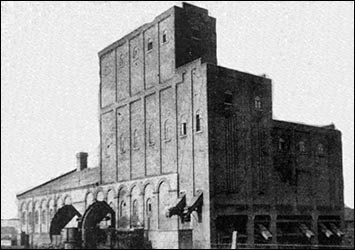 |
|
Retort House
|
With several smaller buildings and about five acres of land the retort house is for sale.
Eighty-five feet high and the biggest building in Rushden, it had a life of a little over eight years. Almost as soon as it was built, it seemed to many, it was closed down.
Under the control of the Rushden and Higham Ferrers District Gas Company the gas producing plant was in action for well over a hundred years. Nationalisation came into force in May 1949 – three years after completion of the new retort house – and when Rushden came on to the “grid” system in September 1955, the works closed down.
Rushden gasworks will become only a shell of its former self when demolition workers complete the dismantling of the interior.
No Takers
Ninety men had been producing an average of just over 90,000cubic feet of gas a day. Linking with the grid brought the number of men crashing down to three shift workers, who also left when everything became fully automatic.
The year 1955 ended and as the years ’56, ’57, ’58 and ’59 came by fresh rumours started that everything was to be pulled down. In actual fact, total demolition would be considered by the East Midlands Gas Board only if it proved absolutely impossible to find a buyer for the property.
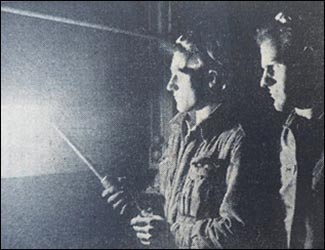 |
|
Cutting the ovens & girders
|
Except for new usable equipment which has been taken out and transferred to works in other areas, buildings and contents were put on the market for sale, as they stood. When it was realised that there would be no takers, it was decided to strip the retort house and leave the shell for easier conversion by prospective buyers.
Negotiations are now going on between the EMGB and one or two interested parties.
The closing down of the works has remained an insoluble mystery to some people but it was all a matter of economics; the Gas Board found it much cheaper to close smaller units and supply all towns with gas from a few very large works at Derby and other centres.
During the past eight weeks men of the Finedon demolition firm of Heath and Hawkes have been busy with oxyacetylene and other equipment to cut through the mighty ovens and great girders in the retort house. Work is expected to continue for another eight weeks,and then what? The future is very uncertain.
Two men with an oxyacetylene torch begin to cut through the great ovens and girders in the retort house.
|
The Rushden Echo, 1st September 1961, transcribed by Jim Hollis
|
Site Cleared For Flats
|
| Demolition work on 15 houses in Kilburn Place, Rushden, is now well under way, and the contractor, Mr. F. J. W. Humphrey, hopes the site will be completely cleared by the end of the week.
The site is being cleared to make way for the building of old people’s flatlets by the urban council – and the bricks from the old houses are being used for a new school in Northampton.
The work, which began ten days ago, is just another routine job for Mr. Humphrey and his team of five.
The inside of the houses are stripped of all fittings first, so that the brickwork can then be pulled down more easily – by a steel hawser attached to a mechanical shovel.
|
|
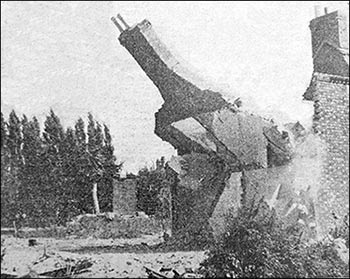 |
The part of the job which takes the most time, said Mr. Humphrey, is the carting away of the rubble. This process involves a continuous stream of lorries which take the rubble – bricks and woodwork from the houses – away from the site.
The contractors are also to knock down a house on Higham Road, beside Kilburn Place, and hope there will be no “assistance” from people who break windows and tear the place apart, thinking that they are helping with the demolition work.
Said Mr. Humphrey: “We get quite a lot of trouble of this sort and it certainly does not help us – we have to gather up all the broken glass around the houses before starting our work.”
Also in Rushden more demolition work is going on, at Woburn Place, off High Street, where the town’s new health clinic is to be built. [Note: These houses were listed for clearance in August 1958 - see 1950s demolition]
|
|
The Rushden Echo, 20th April 1962, transcribed by Jim Hollis
Building Project at Rushden
Demolition and construction work are being carried out simultaneously in Higham Road, Rushden, at the present.
While a block of houses on the east side of the road are in the process of being demolished, Mr. J. A. Bishop, a Rushden contractor, is busy making a new road which will lead to some old people’s bungalows and flatlets off the west side of the Higham Road.
Preparations have been made for the road’s foundations. It will have a 16-foot carriageway with a six-foot footpath, and will run from Higham Road into the ground on which the bungalows are to be built.
The work has been undertaken for the Rushden Urban Council.
|
|
The Rushden Echo, 15th June 1962
‘Bottleneck’ soon to go — This aerial picture of a section of the A6 trunk road at Rushden shows the ‘bottleneck’ between Little Street and Harborough Road which may be removed by 1964-65. The block of terraced houses on the left—Nos. 130-138 High Street South, is likely to be affected by the improvements.
Rushden Urban Council has already told the Ministry of Transport that it will help in rehousing the occupants.
|
|
|
|
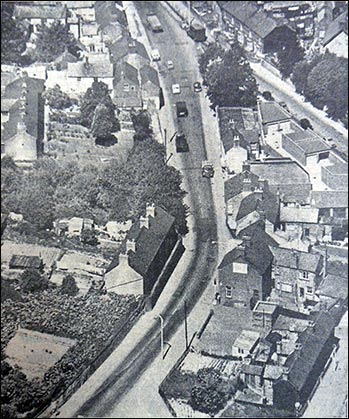 |
High Street South Cottages
Mr Currie of Rushden House built these cottages for the workers on his estate, c1871 and there was a second row behind. The stone cottages, were opposite the Compass Inn. The wall in front of them was constructed of blue engineering quality bricks and steep steps led up to the fronts. |
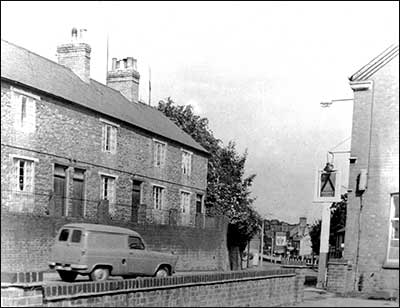 |
The cottages and blue brick wall that were demolished in 1965 for the A6 road widening.
|
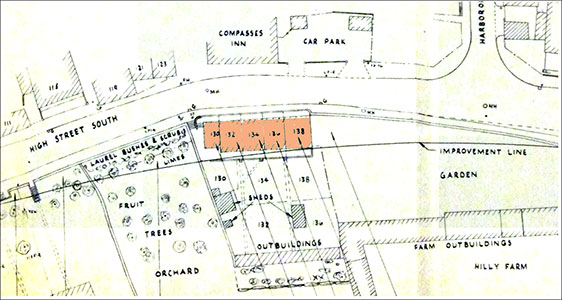
|
|
Plan of the section of High Street South opposite the Compass Inn
|
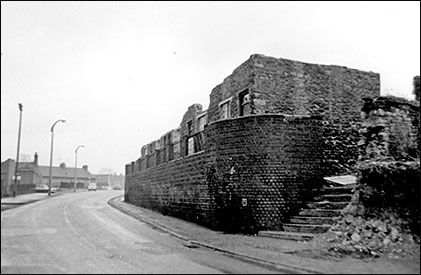 |
|
1965 - The narrow road where the cottages stood - note the steps
|
Rushden Echo, 5th March 1965
Road widening opposite the Compass Inn on the road to Bedford.
|
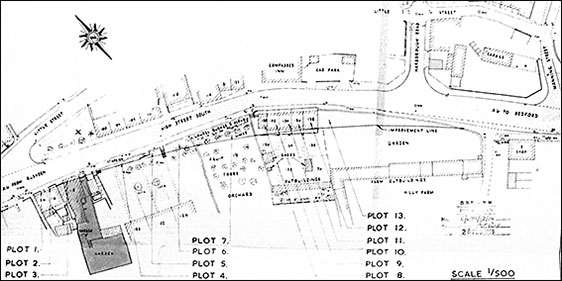 |
|
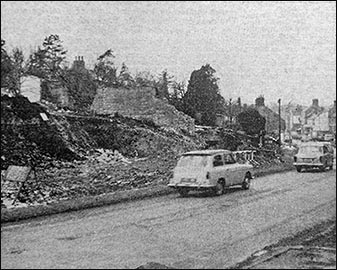 |
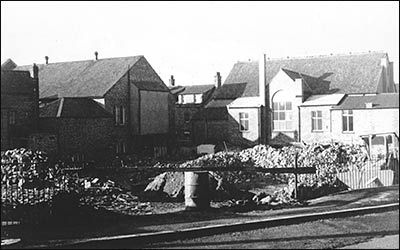 |
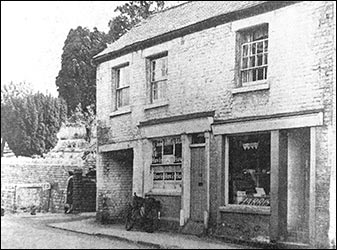 |
|
|
Harris' Bakery at 118 High Street South
Earmarked for demolition in 1965 for road widening.
|
The Rushden Echo, 25th June 1965, transcribed by Jim Hollis
Shopping Precinct Replacing Boarded Up Cottages?
Frequented by teenagers and used by people “sleeping rough” cottages in High Street South, Rushden, boarded up and empty for the past eight months, are being pulled down to make way for what is hoped will be an eight-shop precinct with offices.
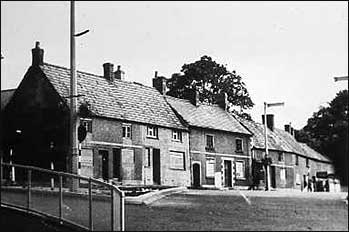 |
|
The cottages due for demolition
|
|
They were bought about eight months ago by the London-based Bedford (Ford End) Property Co. Ltd, and, having been boarded up, were a considerable attraction to young people in the area.
Rushden police have been keeping an eye on the cottages and it is understood that they asked the council whether anything could be done to hasten their demolition.
Mr. I. Haigh, who lives at 36 Griffith Street, at the rear of the cottages, wrote to the property company in March asking if they would erect a barrier at the rear entrance to prevent vandals getting into his back garden. They had broken down his garden wall.
Mr. Haigh told the “Echo”: “These cottages have been a source of bother to us, and all I asked for is that my wall is put right again.” He was interested to hear of the plans for a shopping precinct.
Inspection
The public health inspector, Mr. Humphrey Ellis, said that all the cottages were in an area scheduled for his inspection, to see whether they were fit for habitation. They would probably all have been declared unfit had not the company bought them.
One application for planning permission by the property company has been turned down and it is now awaiting the result of a second revised application which has been sent to the county planning authority for consideration by the Government, as the area is off the main trunk road.
Briefly, these second plans are for shops around a central parking area, extending back to a depth of three shops.
|
|
Courtesy of the late Colin Bryant's Collection
|
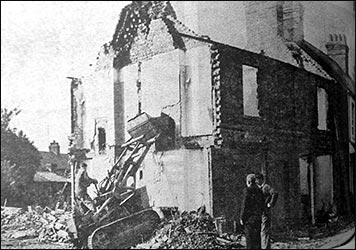 |
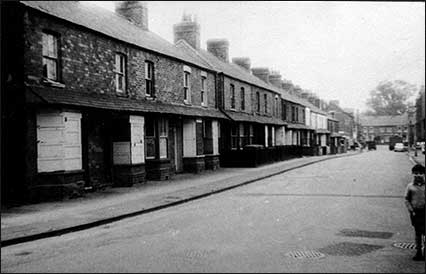 |
|
The part of Cromwell Road demolished in 1965
|
Rushden Echo, 1st October 1965
"The Rock"
Demolition work on houses in “The Rock,” officially known as Cromwell Road, Rushden, started this week. The houses which are being pulled down were built in the late nineteenth century by a London firm, the Rock Freehold Land Society, at a time when Rushden was fast expanding. The name of the firm was somewhat misleading, however, as the society was actually being liquidated when it put up the houses. At present plans for rebuilding on the site are rather vague.
|
|
The Rushden Echo, 17th February 1967, transcribed by Jim Hollis
Succoth Chapel to be demolished
The Succoth Chapel in Rushden High Street, founded in 1805 and later rebuilt, is to be demolished within the next few months.
The disused chapel, owned by Rushden Co-operative Society, is to make way for another society shop, said its managing secretary, Mr. Ralph Griffiths.
Although no definite date has yet to be fixed for the demolition, it will certainly be completed by the end of the summer, and probably sooner.
The bakery, in Newton Road, Rushden, also owned by the Co-operative Society, is to be demolished as well. No plans for development have yet been made in this direction, however.
The bakery was opened at the beginning of the century and it was at that time the latest development in baking and confectionary in the district. The bakery has not been used for some time.
|
The Rushden Echo, 7th March 1969, transcribed by Jim Hollis
Succoth Chapel Makes Way For Supermarket
Take a good look at the Succoth Chapel in Rushden High Street. It is probably the last time you will recognise it as it has stood since the last time it was rebuilt in 1864.
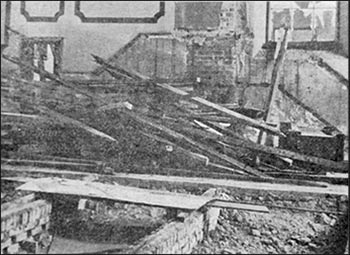 |
|
Inside the chapel
|
The chapel which during the last two decades or more has been unused for the purpose for which it was built in 1805, has, over the years, become more and more of a general eyesore with its general disuse.
But this week work on demolishing the old building started, and Mr. R. R. Griffiths, managing secretary of Rushden Co-operative Society, told the "Echo" that the pulling down job should be finished by the end of the month.
As soon as that job is completed work will start on replacing the chapel with a modern supermarket and men's clothing store.
This new giant store is planned to take over the Succoth Chapel and neighbouring former Gramshaw property sites and will also include at the rear a special department for coal and fuel.
Obsolete
This should provide a fitting end to what could be generally described as a "religious white elephant."
However, although the chapel has long been obsolete as a place of worship, it did enjoy a startling heyday.
It was the meeting place for the Strict and Particular Baptists, a group which left the more formal Baptist movement. They became known as the bottom meeting.
The man who enabled the Succoth Chapel to be built was a young London preacher, Charles Drawbridge, who attracted a wide following.
He was a man with Calvinistic beliefs who was not above using personal abuse and gross vulgarity in the pulpit.
Drawbridge died in the late 19th century but the Strict and Particular Baptists continued to flourish during the early days of this century.
People living in Rushden today can remember the time when the Succoth was so full that chairs had to be used in the aisle to accommodate the congregation.
As Victorian and puritanical thinking was left behind so the Strict Baptist following dwindled. Almost as quickly as it had grown up the Strict and Particular Baptist movement in Rushden declined.
Congregations at the Succoth Chapel became steadily smaller and smaller, and in 1958 it was sold to Rushden Co-operative Society.
Now, 11 years later, the masses could be thronging back to that same, but very different site.
|
| The 'Lightstrung Bus Stop' area |
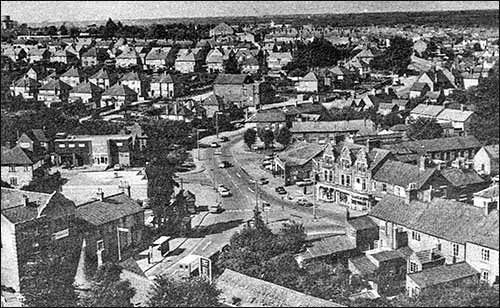 |
| The demolition of several of the buildings seen here happened when the new Duck Street junction was developed. This 1950s picture shows the junction of Duck Street, Church Street, Skinners Hill and St Mary's Avenue, now a roundabout which replaced the building just below the three trees centre - the Lightstrung garage, and behind the trees is the Adult School. The old gas works where the Lightstrung began after the new gas works were built in 1893 in Shirley Road. All the cottages and workshops in Duck Street, and the Adult School dispappeared. Bottom left corner is Stomag - or the old Claridge's factory (demolished in 2015). The large flat roof behind the factory and house cleared in the 1960s to provide new shops for G E Morgan electrical conractors, and a fish and chip shop. Bottom right hand corner is Church Street - the last house was called Ivy Cottage but that was demolished earlier for road alterations. |
|